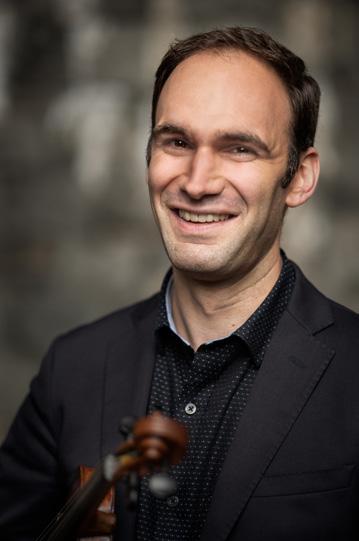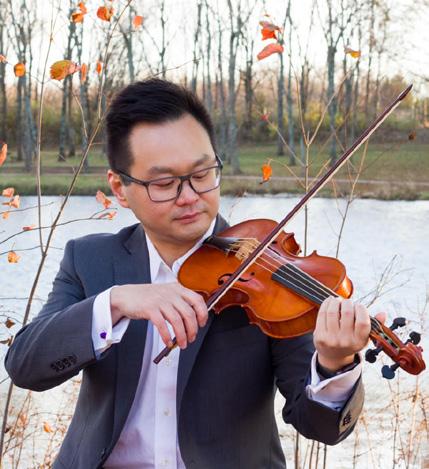








Trio Sonata in G major for two violins and Johann Sebastian Bach basso continuo, BWV 1039 (Leipzig, c. 1736–41) (1685–1750)
Adagio
Allegro ma non presto
“Gulliver’s Travels” Suite for two violins, Georg Philipp Telemann TWV 40:108 (Hamburg, 1728/29) (1681–1767)
Intrada. Spirituoso
Lilliputsche Chaconne (Chaconne of the Lilliputians)
Brobdingnagische Gique (Gigue of the Brobdingngians)
Reverie der Lapoutier, nebst ihren Aufweckern (Daydreams of the Laputians and their attendants)
Loure der gesitteten Houyhnhnms / Furie der unartigen Yahoos (Louré of the civilized Houyhnhnms / Wild dance of the untamed Yahoos)
Trio Sonata in C minor, Carl Philipp Emanuel Bach H. 579 “Sanguineus et Melancholicus” (Potsdam, 1749) (1714–88)
Allegretto – Presto
Adagio
Allegro
BRIEF PAUSE
Trio Sonata in C major, Johann Gottlieb Goldberg
DürG 13 (formerly attrib. J.S. Bach, BWV 1037) (1727–56)
Adagio
Alla breva
On Joy (world premiere) (Saco, Maine, 2024)
Patricia Van Ness commissioned by the Sebastians for the American Bach (b. 1951) Society Biennial Conference
Prologue and Chorale
Allegro
Fantasia
Presto
Chorale
Presto
“Goldberg Sonata” Johann Sebastian Bach
Aria from the Goldberg Variations, BWV 988 (1741) (1685–1750)
Allegro from Sonata no. 6 in G major for violin and harpsichord, BWV 1019 (pre-1725, rev. 1740)
Largo from Sonata in G major for violin and basso continuo, BWV 1021 (1732–5)
Presto from Trio Sonata in G major, BWV 1039
Sonata “La Folia,” op. 1, no. 12, RV 63, Antonio Vivaldi from Suonate da camera a 3 (Venice, 1705) (1678–1741)
Today’s event is sponsored by the Ruth and Noel Monte Fund of the American Bach Society
Ruth and Noel Monte were deeply devoted to Bach and his music, sensing its great impact on the human brain and culture throughout the world. To them, Bach represented a bright planet appearing in the sky only once, requiring centuries for the human mind to observe and fully comprehend. The Monte Fund has the goal of supporting and promoting this living musical treasure for present and future generations.
AboutThe Sebastians (sebastians.org) are a dynamic and vital musical ensemble specializing in music of the baroque and classical eras. Lauded as “everywhere sharp-edged and engaging” (The New York Times), the Sebastians have also been praised for their “well-thought-out articulation and phrasing” (Early Music Review) and “elegant string playing… immaculate in tuning and balance” (Early Music Today). Their 2018 unconducted St. Matthew Passion with TENET Vocal Artists was called “shattering” and “a performance of uncommon naturalness and transparency.” Recent seasons have included dozens of originally conceived programs, including collaborations with poets, choreographers, and actors; a musical installation in the Cathedral of St. John the Divine; programs dealing with musical “immigration” and nationalism; and major works of J.S. Bach led from the keyboard.
Winners of the Audience Prize at the 2012 Early Music America Baroque Performance Competition, the Sebastians were also finalists in the 2011 York International Early Music Competition and the 2011 Early Music America/Naxos Recording Competition. They have performed at Music Matters (LaGrua Center in Stonington, CT), Friends of Music at Pequot Library (Southport, CT), St. John’s Episcopal Church (Tulsa, OK), Juilliard in Aiken (SC), in the Twelfth Night Festival and Concerts@One at Trinity Wall Street (New York, NY), Early Music in Columbus (Ohio), the Renaissance and Baroque Society of Pittsburgh (PA), the Academy of Early Music (MI), and Houston Early Music (TX). The Sebastians are currently in residence at the Yale Collection of Musical Instruments.
The ensemble’s recordings range from Night Scenes from the Ospedale, pairing Vivaldi concerti with newly composed interludes by Robert Honstein (“beautifullynuanced playing and thoughtful expressivity”); to the Sebastians a 2: Virtuoso Music of the Holy Roman Empire, exploring the rich baroque repertoire of music for violin and harpsichord written by composers from modern-day Germany, Austria, and the Czech Republic; and Folia, which juxtaposes trio sonatas and vocal works by Corelli, Colista, Handel, and Vivaldi, featuring soprano Awet Andemicael.

Violinist Nicholas DiEugenio has been heralded for his “excellent...evocative” playing (The New York Times), full of “rapturous poetry” (American Record Guide). Nicholas is in-demand as a soloist, chamber musician, and ensemble leader, creating powerful shared experiences in music ranging from early baroque to contemporary commissions. His award-winning album “Unraveling Beethoven” with pianist and wife Mimi Solomon was released in 2018 by New Focus Recordings, and other recordings include the complete Violin Sonatas of Robert Schumann (Musica Omnia) as well as a tribute to Pulitzer prizewinner Steven Stucky (New Focus). Nicholas is a core member of the Sebastians as well as Associate Professor of Music at UNC Chapel Hill. Nicholas plays a J.B. Vuillaume violin (1835) as well as a Karl Dennis baroque violin (2011). www.nicholasdieugenio.com @dieu_violin

Keyboardist and conductor Jeffrey Grossman specializes in vital, engaging performances of music of the past, through processes that are intensely collaborative and historically informed. As the artistic director of the Sebastians, Jeffrey has directed Bach’s Passions and Handel’s Messiah from the organ and harpsichord, and he is a frequent performer with TENET, the Saint Paul Chamber Orchestra, and numerous other ensembles across the country. Recent seasons include his conducting operas of Haydn and Handel with Juilliard Opera, leading Monteverdi’s Vespers with the Green Mountain Project in New York and Venice, and conducting a workshop of a new Vivaldi pastiche opera for the Metropolitan Opera. A native of Detroit, Michigan, he holds degrees from Harvard, Juilliard, and Carnegie Mellon University. Jeffrey teaches performance practice at Yale University. jeffreygrossman.com

Daniel S. Lee thrives in the intersection of the arts and spirituality. His work involves redefining the roles of sacred and secular music with regards to their intention, function, and venue. Praised by The New York Times as “soulful” and “ravishing,” he performs as a period violinist and leader with various ensembles throughout the United States and Europe, including his own, the Sebastians. He currently serves as the concertmaster for the Providence Baroque Orchestra (RI) and the resident baroque orchestra at the Washington National Cathedral (DC). He performs on various historical instruments and fosters ongoing collaborative research with luthier Karl Dennis (Warren, RI) and bowmaker David Hawthorne (Waltham, MA). When not traveling and performing, he splits his time between Willard, MO, where he pastors a Presbyterian Church (USA) congregation, and New Haven, CT, where he teaches early music at the Yale School of Music. Born in Chicago and raised in Seoul (South Korea) and in New York City, Daniel is equally (un)fluent in Korean and in English. He identifies himself as ethnically a New Yorker. He enjoys learning different languages and cultures, and is a student of various ancient languages.

Hailed for his “scampering virtuosity” (American Record Guide) and “superb” playing (The New York Times), cellist Ezra Seltzer is the principal cellist of the Trinity Baroque Orchestra, New York Baroque Incorporated, and Early Music New York and a founding member of the Sebastians. He has frequently appeared as guest principal cellist of Musica Angelica and the St. Paul Chamber Orchestra, where he earned praise for his “delicate elegance and rambunctious spirit” (Twin Cities Pioneer Press). He attended Yale University, where he received his Bachelor of Arts in history and Master of Music in cello, and graduated from the inaugural class of Juilliard’s historical performance program.


Music at Emory brings together students, faculty, and world-class artists to create an exciting and innovative season of performances, lectures, workshops, and master classes. With more than 150 events each year across multiple Emory venues, audiences experience a wide variety of musical offerings.
We hope you enjoy sampling an assortment of work from our student ensembles, community youth ensembles, artists in residence, professional faculty, up-and-coming prodigies, and virtuosos from around the world.
music.emory.edu



